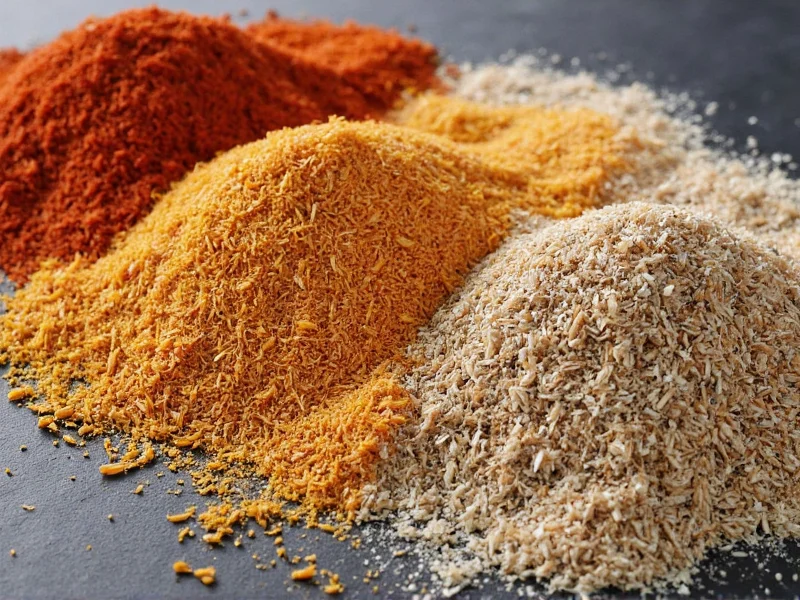Dry seasoning mixes represent one of the most versatile tools in modern cooking, combining convenience with culinary precision. Understanding their composition and proper usage can transform ordinary meals into restaurant-quality dishes. These blends work through controlled release of flavor compounds when exposed to moisture and heat during cooking, creating complex taste experiences that single spices often can't achieve.
The Science Behind Effective Dry Seasoning Formulations
Professional-grade dry seasoning mixes follow precise scientific principles to ensure consistent performance. The particle size of each component matters significantly—finely ground ingredients dissolve more uniformly, while coarser elements provide texture and delayed flavor release. Salt crystals typically range from 100-500 microns, while herbs and spices are milled to 200-800 microns for optimal dispersion.
Anti-caking agents like silicon dioxide (typically 0.5-2% of the blend) prevent moisture absorption that causes clumping. These food-grade compounds create microscopic barriers between particles without affecting flavor. The ideal moisture content for stable dry seasoning mixes stays below 5%, which explains why humidity dramatically affects their shelf life.
| Component | Typical Percentage | Primary Function |
|---|---|---|
| Salt | 30-60% | Flavor enhancer and preservative |
| Spice Blends | 20-40% | Primary flavor profile |
| Sugar | 5-15% | Balances acidity and enhances browning |
| Anti-caking Agents | 0.5-2% | Prevents moisture absorption |
| Flavor Enhancers | 1-5% | Boosts umami and complexity |
Commercial vs. Homemade Dry Seasoning Mixes: A Practical Comparison
When evaluating how to use dry seasoning mixes properly, understanding the differences between commercial and homemade options is essential. Commercial blends benefit from industrial milling processes that achieve uniform particle size, while homemade versions allow complete ingredient control. The sodium content in store-bought mixes often exceeds homemade versions by 25-40%, making customization valuable for dietary restrictions.
Professional chefs frequently combine both approaches—using commercial bases for consistency while adding fresh elements for complexity. For example, a standard taco seasoning mix might be enhanced with freshly toasted cumin seeds and smoked paprika for depth. This hybrid method leverages the convenience of pre-mixed seasonings while introducing artisanal touches.
Mastering Dry Seasoning Application Techniques
The timing of dry seasoning incorporation significantly impacts final flavor. For dry rubs on meats, applying the mix 30-60 minutes before cooking allows salt to penetrate while spices remain on the surface. In soups and stews, adding dry mixes during the last 15-20 minutes of cooking preserves volatile flavor compounds that would otherwise dissipate.
When converting liquid recipes to dry seasoning, use this professional ratio: replace 1 tablespoon of liquid seasoning with 1 teaspoon of dry mix, then adjust to taste. This accounts for the concentration difference while preventing over-seasoning. For baking applications, always sift dry seasoning mixes with other dry ingredients to ensure even distribution without clumping.
Creating Custom Dry Seasoning Blends
Developing personalized dry seasoning mix recipes requires understanding flavor layering principles. Start with a base ratio of 4 parts salt, 2 parts primary spice, 1 part secondary flavor, and 0.5 parts accent. For a versatile all-purpose blend: 4 tablespoons kosher salt, 2 tablespoons garlic powder, 1 tablespoon onion powder, 1 teaspoon black pepper, and ½ teaspoon cayenne.
Dry seasoning mix storage tips are critical for maintaining potency. Store blends in amber glass containers to block light degradation, and include a silica packet to absorb ambient moisture. Properly stored mixes retain 80% of their flavor compounds for 6 months, compared to just 3 months in clear containers. Avoid storing near cooking areas where temperature fluctuations occur.
Specialized Applications and Troubleshooting
Certain cooking methods require dry seasoning adjustments. For sous vide preparation, reduce salt content by 25% since flavors concentrate in the sealed environment. When using dry mixes in pressure cooking, increase liquid content by 10% to compensate for the salt's moisture absorption during the cooking process.
Common dry seasoning issues often stem from improper measurement. Always use level measurements rather than heaping spoons, and aerate compacted mixes before measuring. If a dish becomes over-seasoned, add an uncooked potato wedge during simmering—it will absorb excess salt without altering other flavors significantly.
Frequently Asked Questions
Can I substitute dry seasoning mix for fresh herbs?
Dry seasoning blends cannot directly replace fresh herbs due to concentration differences. As a general rule, use 1 teaspoon of dry seasoning mix to replace 1 tablespoon of fresh herbs. Remember that dry mixes contain salt and other components beyond just herbs, so adjust additional salt accordingly in your recipe.
Why do my homemade dry seasoning mixes clump?
Clumping occurs when moisture penetrates your blend. Ensure all ingredients are completely dry before mixing—toast spices in a 200°F oven for 5-10 minutes if needed. Always include ¼ teaspoon of cornstarch or silica gel per cup of mix as a natural anti-caking agent. Store in airtight containers with a moisture-absorbing packet for best results.
How do I adjust dry seasoning mixes for dietary restrictions?
For low-sodium diets, replace salt with equal parts potassium chloride or mushroom powder. To make gluten-free mixes, verify all spice components are processed in dedicated facilities. For sugar-free versions, substitute with equal parts nutritional yeast or additional herbs. Always check individual spice labels as some commercial seasonings contain hidden allergens.
What's the best way to measure dry seasoning mixes accurately?
Use the dip-and-sweep method: dip your measuring spoon directly into the seasoning container, then level with a straight edge. Never scoop from above as this compacts the mix. For critical recipes, weigh your seasonings—1 teaspoon of most dry seasoning blends weighs 5-6 grams. Aerate compacted mixes by stirring before measuring to ensure consistent density.
Can I use dry seasoning mixes in baking?
Yes, but with adjustments. Sift dry seasoning mixes thoroughly with other dry baking ingredients to prevent clumping. Reduce added salt by 25% since seasoning blends already contain sodium. For sweet applications like spiced cookies, increase sugar content by 10% to balance the savory elements. Start with smaller amounts (¼ teaspoon per cup of flour) and adjust to taste.











 浙公网安备
33010002000092号
浙公网安备
33010002000092号 浙B2-20120091-4
浙B2-20120091-4